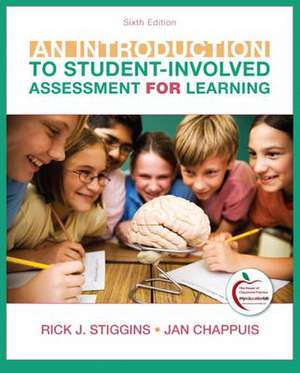Introduction to Student-Involved Assessment for Learning, an with Myeducationlab with Enhanced Pearson Etext, Loose-Leaf Version -- Access Card Packag
Autor Rick Stiggins, Jan Chappuisen Limba Engleză Mixed media product – 27 aug 2015
Preț: 921.32 lei
Preț vechi: 1196.53 lei
-23% Nou
Puncte Express: 1382
Preț estimativ în valută:
176.30€ • 184.44$ • 146.45£
176.30€ • 184.44$ • 146.45£
Indisponibil temporar
Doresc să fiu notificat când acest titlu va fi disponibil:
Se trimite...
Preluare comenzi: 021 569.72.76
Specificații
ISBN-13: 9780133436518
ISBN-10: 0133436519
Pagini: 360
Dimensiuni: 191 x 235 x 16 mm
Greutate: 0.54 kg
Ediția:Revised
Editura: Pearson
ISBN-10: 0133436519
Pagini: 360
Dimensiuni: 191 x 235 x 16 mm
Greutate: 0.54 kg
Ediția:Revised
Editura: Pearson
Textul de pe ultima copertă
From reviews of the text: "The text clearly lays out assessment design for beginners. It is clear and easy to read. . . . The overall clarity of the text makes this textbook an important tool in educating pre-service teachers." Xyanthe Neider, Washington State University "The overall theme of this text is that assessment is a deliberate, thoughtful process done on many levels that can enhance and guide the instructional process. The text moves students from the general (What is assessment?) to the specific (How do you create a multiple choice test that will provide valid and reliable data?), helping students understand the vital connection between instruction and assessment along the way. . . . The focus on assessment for learning . . . is an important way of considering assessment that most students do not think about. . . . As school districts begin using the Common Core standards, incorporating assessment for learning should become an important component of instruction. This text helps students understand the many facets of thinking about assessment this way and helps them learn how to design their assessments to be used in this way." Leigh Ausband, UNC Charlotte "This text is a valuable addition to . . . classroom assessment textbooks because of its focus on promoting assessment for learning. . . . [M]any existing textbooks do not use this terminology (assessment for, of, and as learning) rather [they] rely on more traditional notions of formative and summative assessment. The newer terminology brings with it more contemporary uses and conceptions of assessment that serve a mandate to support learning through integrated assessments. This message is made clear throughout the text. I also appreciate that the textbook draws on traditional teachings in assessment to establish that assessment for learning does not require a whole new set of assessment techniques. . . . [This text] advances an important (new) mission for educational assessment. I hope it is widely adopted, as I believe it has the capacity to reshape teacher candidates' conceptions of assessment as a central teaching and learning tool." Christopher DeLuca, University of South Florida
